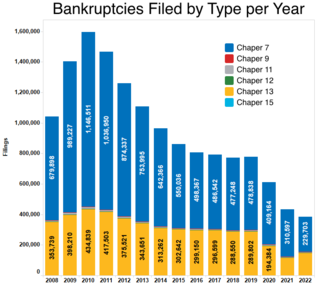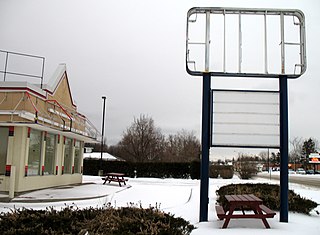Related Research Articles
Bankruptcy is a legal process through which people or other entities who cannot repay debts to creditors may seek relief from some or all of their debts. In most jurisdictions, bankruptcy is imposed by a court order, often initiated by the debtor.
Chapter 11 of the United States Bankruptcy Code permits reorganization under the bankruptcy laws of the United States. Such reorganization, known as Chapter 11 bankruptcy, is available to every business, whether organized as a corporation, partnership or sole proprietorship, and to individuals, although it is most prominently used by corporate entities. In contrast, Chapter 7 governs the process of a liquidation bankruptcy, though liquidation may also occur under Chapter 11; while Chapter 13 provides a reorganization process for the majority of private individuals.
Chapter 7 of Title 11 U.S. Code is the bankruptcy code that governs the process of liquidation under the bankruptcy laws of the U.S. In contrast to bankruptcy under Chapter 11 and Chapter 13, which govern the process of reorganization of a debtor, Chapter 7 bankruptcy is the most common form of bankruptcy in the U.S.
Title 11 of the United States Code sets forth the statutes governing the various types of relief for bankruptcy in the United States. Chapter 13 of the United States Bankruptcy Code provides an individual with the opportunity to propose a plan of reorganization to reorganize their financial affairs while under the bankruptcy court's protection. The purpose of chapter 13 is to enable an individual with a regular source of income to propose a chapter 13 plan that provides for their various classes of creditors. Under chapter 13, the Bankruptcy Court has the power to approve a chapter 13 plan without the approval of creditors as long as it meets the statutory requirements under chapter 13. Chapter 13 plans are usually three to five years in length and may not exceed five years. Chapter 13 is in contrast to the purpose of Chapter 7, which does not provide for a plan of reorganization, but provides for the discharge of certain debt and the liquidation of non-exempt property. A Chapter 13 plan may be looked at as a form of debt consolidation, but a Chapter 13 allows a person to achieve much more than simply consolidating his or her unsecured debt such as credit cards and personal loans. A chapter 13 plan may provide for the four general categories of debt: priority claims, secured claims, priority unsecured claims, and general unsecured claims. Chapter 13 plans are often used to cure arrearages on a mortgage, avoid "underwater" junior mortgages or other liens, pay back taxes over time, or partially repay general unsecured debt. In recent years, some bankruptcy courts have allowed Chapter 13 to be used as a platform to expedite a mortgage modification application.
Personal bankruptcy law allows, in certain jurisdictions, an individual to be declared bankrupt. Virtually every country with a modern legal system features some form of debt relief for individuals. Personal bankruptcy is distinguished from corporate bankruptcy.

In the United States, bankruptcy is largely governed by federal law, commonly referred to as the "Bankruptcy Code" ("Code"). The United States Constitution authorizes Congress to enact "uniform Laws on the subject of Bankruptcies throughout the United States". Congress has exercised this authority several times since 1801, including through adoption of the Bankruptcy Reform Act of 1978, as amended, codified in Title 11 of the United States Code and the Bankruptcy Abuse Prevention and Consumer Protection Act of 2005 (BAPCPA).

In accounting, insolvency is the state of being unable to pay the debts, by a person or company (debtor), at maturity; those in a state of insolvency are said to be insolvent. There are two forms: cash-flow insolvency and balance-sheet insolvency.

The Bankruptcy Abuse Prevention and Consumer Protection Act of 2005 (BAPCPA) is a legislative act that made several significant changes to the United States Bankruptcy Code.
The homestead exemption in Florida may refer to three different types of homestead exemptions under Florida law:
- exemption from forced sale before and at death per Art. X, Section 4(a)-(b) of the Florida Constitution;
- restrictions on devise and alienation, Art. X, Section 4(c) of the Florida Constitution;
- and exemption from taxation per Art. VII, Section 6 of the Florida Constitution.
A fraudulent conveyance or fraudulent transfer is the transfer of property to another party to prevent, hinder, or delay the collection of a debt owed by or incumbent on the party making the transfer, sometimes by rendering the transferring party insolvent. It is generally treated as a civil cause of action that arises in debtor/creditor relations, typically brought by creditors or by bankruptcy trustees against insolvent debtors, but in some jurisdictions there is potential for criminal prosecution.
A bankruptcy discharge is a court order that releases an individual or business from specific debts and obligations they owe to creditors. In other words, it's a legal process that eliminates the debtor's liability to pay certain types of debts they owe before filing the bankruptcy case.

The Bankruptcy and Insolvency Act is one of the statutes that regulates the law on bankruptcy and insolvency in Canada. It governs bankruptcies, consumer and commercial proposals, and receiverships in Canada.
An unfair preference is a legal term arising in bankruptcy law where a person or company transfers assets or pays a debt to a creditor shortly before going into bankruptcy, that payment or transfer can be set aside on the application of the liquidator or trustee in bankruptcy as an unfair preference or simply a preference.
Asset protection is a set of legal techniques and a body of statutory and common law dealing with protecting assets of individuals and business entities from civil money judgments. The goal of asset protection planning is to insulate assets from claims of creditors without perjury or tax evasion.
Toibb v. Radloff, 501 U.S. 157 (1991), was a case in which the United States Supreme Court held that individuals are eligible to file for relief under the reorganization provisions of chapter 11 of the United States Bankruptcy Code, even if they are not engaged in a business. The case overturned the lower courts ruling which restricted individuals to chapter 7.
The insolvency law of Switzerland is the law governing insolvency, foreclosure, bankruptcy and debt restructuring proceedings in Switzerland. It is principally codified in the Federal Statute on Debt Enforcement and Bankruptcy of 11 April 1889 as well as in ancillary federal and cantonal laws.
Bankruptcy in Irish Law is a legal process, supervised by the High Court whereby the assets of a personal debtor are realised and distributed amongst his or her creditors in cases where the debtor is unable or unwilling to pay his debts.

Commercial insolvency in Canada has options and procedures that are distinct from those available in consumer insolvency proceedings. It is governed by the following statutes:
Law v. Siegel, 571 U.S. 415 (2014), is a ruling of the Supreme Court of the United States that describes the extent of the powers of bankruptcy courts in dealing with the bad faith of debtors.
Bank of America, N. A. v. Caulkett, 575 U.S. 790, 135 S. Ct. 1995 (2015), is a bankruptcy law case decided by the Supreme Court of the United States on June 1, 2015. In Caulkett, the Court held that 11 U.S.C. § 506(d) does not permit a Chapter 7 debtor to void a junior mortgage on the debtor's property when the amount of the debt secured by the senior mortgage on that property exceeds the property's current market value.
References
- ↑ "Bankruptcy Code, Section 101". August 30, 2014. Retrieved August 30, 2014.
- ↑ "Bankruptcy Abuse Prevention and Consumer Protection Act of 2005". August 30, 2014. Archived from the original on December 20, 2012. Retrieved August 30, 2014.
- ↑ "Bankruptcy Court of the Southern District of Florida". August 30, 2014. Archived from the original on September 25, 2014.
- ↑ http://www.flmb.uscourts.gov/ . Retrieved September 1, 2014.
{{cite web}}: Missing or empty|title=(help) - ↑ "Locations of Bankruptcy Courts of the Middle District of Florida". September 1, 2014. Retrieved September 1, 2014.
- ↑ . September 1, 2014 https://web.archive.org/web/20140924061513/http://www.flmb.uscourts.gov/filing_without_attorney/. Archived from the original on September 24, 2014. Retrieved September 1, 2014.
{{cite web}}: Missing or empty|title=(help) - ↑ . September 1, 2014 https://web.archive.org/web/20140924061513/http://www.flmb.uscourts.gov/filing_without_attorney/. Archived from the original on September 24, 2014. Retrieved September 1, 2014.
{{cite web}}: Missing or empty|title=(help) - ↑ "Volunteers from the Tampa Bay Bankruptcy Bar Association" (PDF). September 1, 2014. Archived from the original (PDF) on April 1, 2014. Retrieved September 1, 2014.
- ↑ "Official Bankruptcy Forms". August 30, 2014. Retrieved August 30, 2014.
- ↑ "Official Form B1" (PDF). August 1, 2014. Retrieved August 1, 2014.
- ↑ "11 USC Section 541(a)". September 1, 2014. Retrieved September 1, 2014.
- ↑ "Florida Constitution". Archived from the original on December 8, 2008. Retrieved August 30, 2014.
- ↑ "Florida's Unlimited Homestead Exemption Does Have Some Limits, Part I". September 1, 2014. Retrieved September 1, 2014.
- ↑ "Florida Department of Revenue, Individual and Family Exemptions". September 1, 2014. Retrieved September 1, 2014.
- ↑ "The Florida Homestead – Three Different Contexts". September 1, 2014. Archived from the original on September 4, 2014. Retrieved September 1, 2014.
- ↑ "Florida Personal Property Exemptions". September 1, 2014. Retrieved September 1, 2014.[ permanent dead link ]
- ↑ "Florida Constitution". August 30, 2014. Archived from the original on December 8, 2008.
- ↑ "Florida Statute 222.11" . Retrieved August 30, 2014.
- ↑ "Florida Statutes 222.13". August 30, 2014.
- ↑ "Florida Statutes 222.14".
- ↑ "Florida Statutes 222.14".
- ↑ "Florida Exemption of Workers' Compensation Benefits". September 1, 2014. Archived from the original on September 4, 2014. Retrieved September 1, 2014.
- ↑ "Florida Tenants by Entireties Exemption". September 1, 2014. Archived from the original on September 4, 2014. Retrieved September 1, 2014.
- ↑ "11 USC Section 541(d)". September 1, 2014. Retrieved September 1, 2014.
- ↑ "Florida's New Trust Law". September 1, 2014. Retrieved September 1, 2014.
- ↑ "11 USC Section 541(d)". September 1, 2014. Retrieved September 1, 2014.
- ↑ "11 USC Section 101 (10)". September 1, 2014. Retrieved September 1, 2014.
- ↑ "Creditor Claim Guide" (PDF). September 1, 2014. Retrieved September 1, 2014.
- ↑ "Northern Pipeline v. Marathon Pipe Line, 458 U.S. 50 (1982)". September 1, 2014. Retrieved September 1, 2014.
- ↑ "Stern v. Marshall, Slip Opinion, decided June 23, 2011" (PDF). July 1, 2014. Retrieved July 1, 2014.
- ↑ "Article III, United States Constitution". September 1, 2014. Retrieved September 1, 2014.
- ↑ "Federal Rules of Bankruptcy Procedure" (PDF). Archived from the original (PDF) on 2014-12-22.
- ↑ "Federal Rules of Civil Procedure".
- ↑ "Federal Rules of Evidence". August 30, 2014. Retrieved August 30, 2014.
- ↑ "Chapter 7 under the Bankruptcy Code". September 1, 2014. Retrieved September 1, 2014.
- ↑ "Chapter 13 of the Bankruptcy Code". September 1, 2014. Retrieved September 1, 2014.
- ↑ "National Association of Consumer Bankruptcy Attorneys". August 30, 2014. Archived from the original on September 27, 2014. Retrieved August 30, 2014.
- ↑ "American Bankruptcy Institute". August 30, 2014. Retrieved August 30, 2014.
- ↑ "Case Digest Data Base". September 1, 2014. Retrieved September 1, 2014.
- ↑ "Bankruptcy Court Decisions". August 30, 2014. Archived from the original on September 25, 2014. Retrieved August 30, 2014.
- ↑ "Farsad Law Office" . Retrieved March 22, 2021.